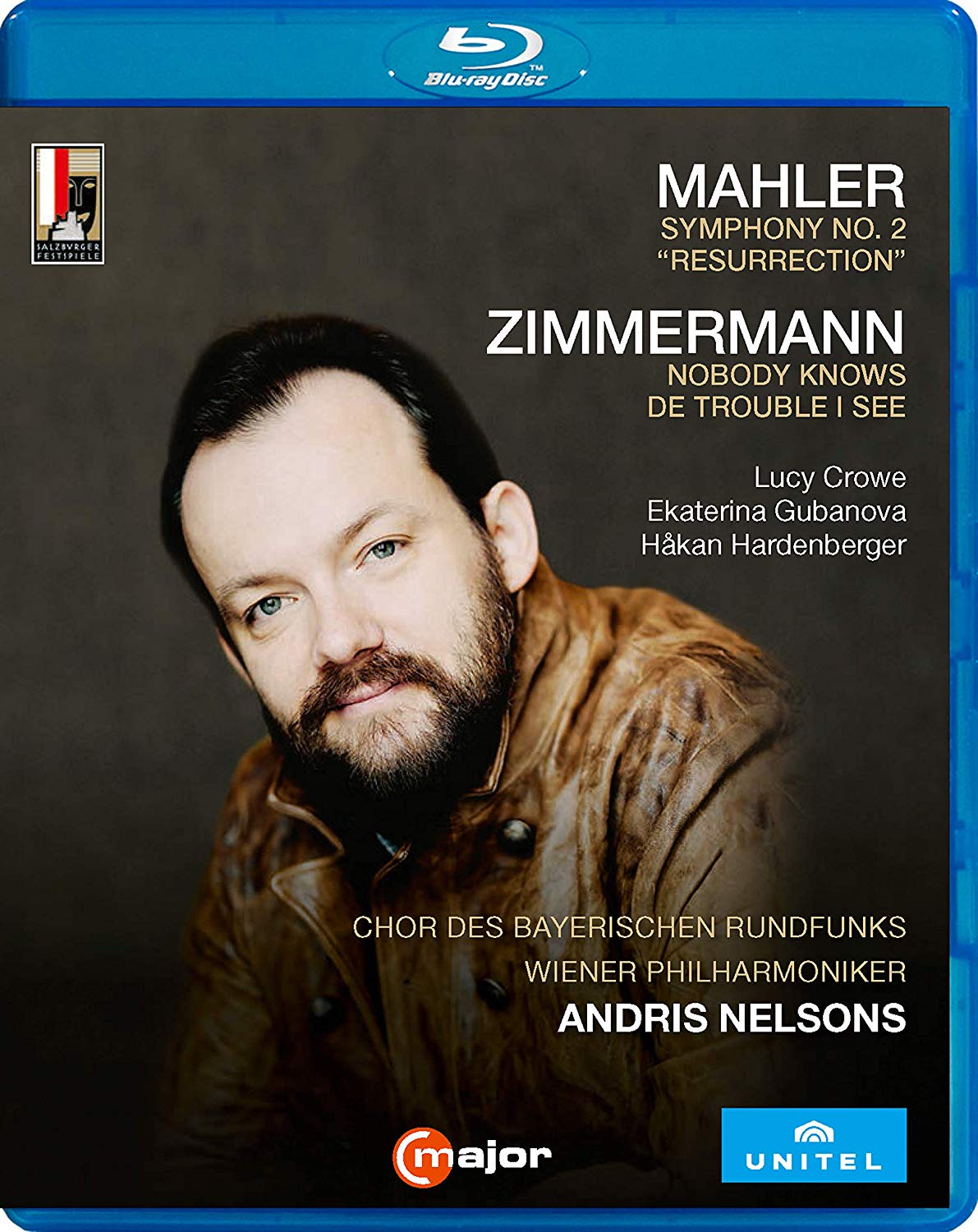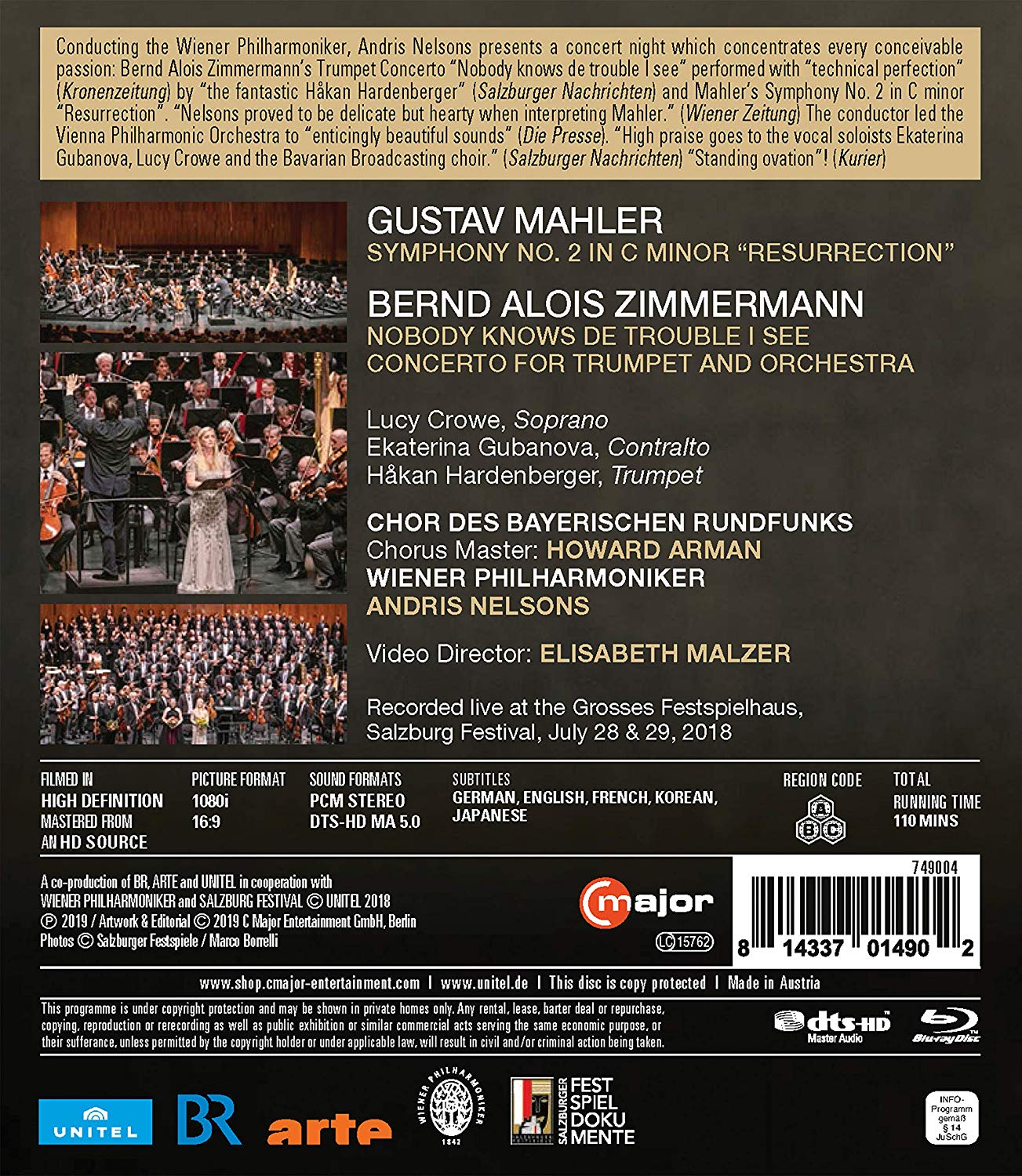

Mahler Symphony and Zimmerman Trumpet Concerto concert. In 2018 Andris Nelsons conducted the Wiener Philharmoniker and the Chor des Bayerischen Rundfunks at the Grosses Festspielhaus as part of the Salzburg Festival. Music performed:
Mahler Symphony No. 2 with soprano Lucy Crowe and contralto Ekaterina Gubanova
Bernd Alois Zimmerman Trumpet Concerto Nobody Knows the Trouble I See with soloist Håkan Hardenberger
Directed for TV by Elizabeth Malzer. Includes subtitles German, English, French, Korean, and Japanese, a feature often omitted by careless publishers of Mahler 2. Released 2019, disc has 5.0 dts-HD Master Audio sound. Grade: C+
We now (Jan. 2020) have 9 Blu-ray recordings of Mahler 2. But only one of them is graded higher than C+. Everything we have is infected with DVDitis! When we first saw the generous YouTube clip below from C Major with good PQ and many long-range, big-picture shots, we were optimistic that Elizabeth Malzer maybe had produced a video free of the dread disease of DVDitis. Wonk Bryan Balmer volunteered to do a review. Alas, our hopes were dashed again.
First we will show you some screen shots. Then we have a summary Wonk Worksheet done by Balmer pointing out the problems with Malzer’s video content.
Lets look first at some whole-orchestra (WO) shots. The first shot below comes late in the piece when the soloists sing of the resurrection. Some horn players are returning from playing off-stage. This nice shot even gets in the organ. And this view of the soloists is what we call “realistic”, since it’s a view that would be seen by folks in the live audience:
Here’s another beautiful WO shot (maybe a handful of players on the right are missing). We see the backs of some of the players, but that’s OK because from this angle we can see all the first violins and many other sections:
Next below is a nice part-orchestra (“PO”) shot:
And next is an example of a multi-section shot because it includes a percussionist, all the trumpets, and most of the horns. We like to see as many WO, PO, and multi-section shots as possible. This is especially important when there is a chorus behind the orchestra. These are the shots which take full advantage of high-definition video cameras and comes closer to the experience that a member of the live audience has at the symphony. But, alas, the video industry is still making symphony recordings with the DVD market in mind. DVD cameras don’t have the resolution needed to make large-scale shots successfully. So the TV director winds up mostly making short clips of small groups of players in what we call a “roadrunner” race around the orchestra. For more on this see our special article on DVDitis:
Shots of the whole chorus tend to be shots of the WO as well. There are a number of decent part-chorus clips in the video also like the view below:
The shot of the soloist below is “not-realistic” because it is too close to have been seen by an audience member. We prefer for the shots of the soloists to show the whole body or at least from the waist up:
Next below is a whole-section shot with all 8 double-bass players (just barely) shown:
And next we have a part-section shot of more than half the cellos:
In a DVD, most of the clips show small groups of players like the next 3 shots below:
The organist (his music fits on one page!):
Now we turn our attention to conductor shots. The live audience doesn’t see much of the conductor other than his back. But makers of DVDs of symphony music love to make tons of shots of the conductor. Why? Because it’s so easy to do! It doesn’t make any difference what the orchestra is doing. Rather than trying to follow the music in your video plan, just shoot the conductor!
The next shot below is also bad because it’s not realistic. No audience member would be able to see this:
And below is the worst crime of all — a conductor-over-backs shot! It’s insulting to the conductor because it such a lousy view of him. And it’s insulting to a large number of players including all those with their backs shown and the string players on the other side of the stage. Every player in this orchestra is a world-class expert on his instrument. Each player should always be pictured in the most flattering light possible and never like this:
Finally, we get way too many shots in our symphony videos that are just bad. The next two below are “instrument-only” shots. There are times when an instrument deserves special attention, but 95% of these shots are just the result of slovenliness by the TV director and/or editor:
And we also get a fair number of video atrocities like the out-of-focus instrument-only shot below. There is no excuse for bad workmanship like this in a symphony video:
Now let’s see what Wonk Balmer found when he studied the various kinds of shots in Malzer’s video. Balmer took as his sample 3 of the 5 movements of the symphony. The pace is figured by dividing the length of the sample by the number of clips in the sample.
Here then are our rules: A good HDVD should have a slow pace with more than 10 seconds per video clip on average (longer the better). 20 to 40% (higher is better) of the clips should be large-scale "supershots" (the total of whole-orchestra, part-orchestra, multiple-section, and large-section shots). Conductor shots should be less than 20% (way less really) of the clips in the video. And if there is a soloist, more than 50% of the shots of the soloist should be realistic. Here are Balmer’s figures:
| 1st Movement | 4th and 5th Movements | |
| Duration (min:sec) | 23:43 | 43:04 |
| Pace | 8.5 s per clip | 9.4 s per clip |
| Supershots | 26.8 % | 23.7 % |
| Conductor | 15.5 % | 15.3 % |
| % realistic soloist shots | not applicable | 18.2 % |
| Instrument-only shots | 11.3 % |
9.1 %
|
Time for a grade. It goes without saying that the musical performance and SQ here were good. Start with Grade A+, deduct for pace to B+ (not 10 seconds or more per clip). Supershots and Conductor scores are OK. Deduct a partial grade for soloist shots being too close-up and therefore unrealistic. This brings us to B-. Deduct further for the large number of instrument only shots (19 in the first movement, 25 in the 4th and 5th movements). This results in a C+ grade. Performance was enjoyable, but not so much as to warrant a nudge up to B-.
So we are still stuck with 9 Mahler 2 recordings and not a single one gets an A. The last 12 years of recording symphony performances for Blu-ray disks has largely been a catastrophe as far as the European record publishing houses are concerned. But sooner or later the publishers will start selling more Blu-rays than DVDs. Then they will start making modern recordings that we can be proud to display in the HT. It follows then that the real opportunity for the publishing houses to make great symphony recordings still lies in the future.
Here’s the official trailer:
OR


















